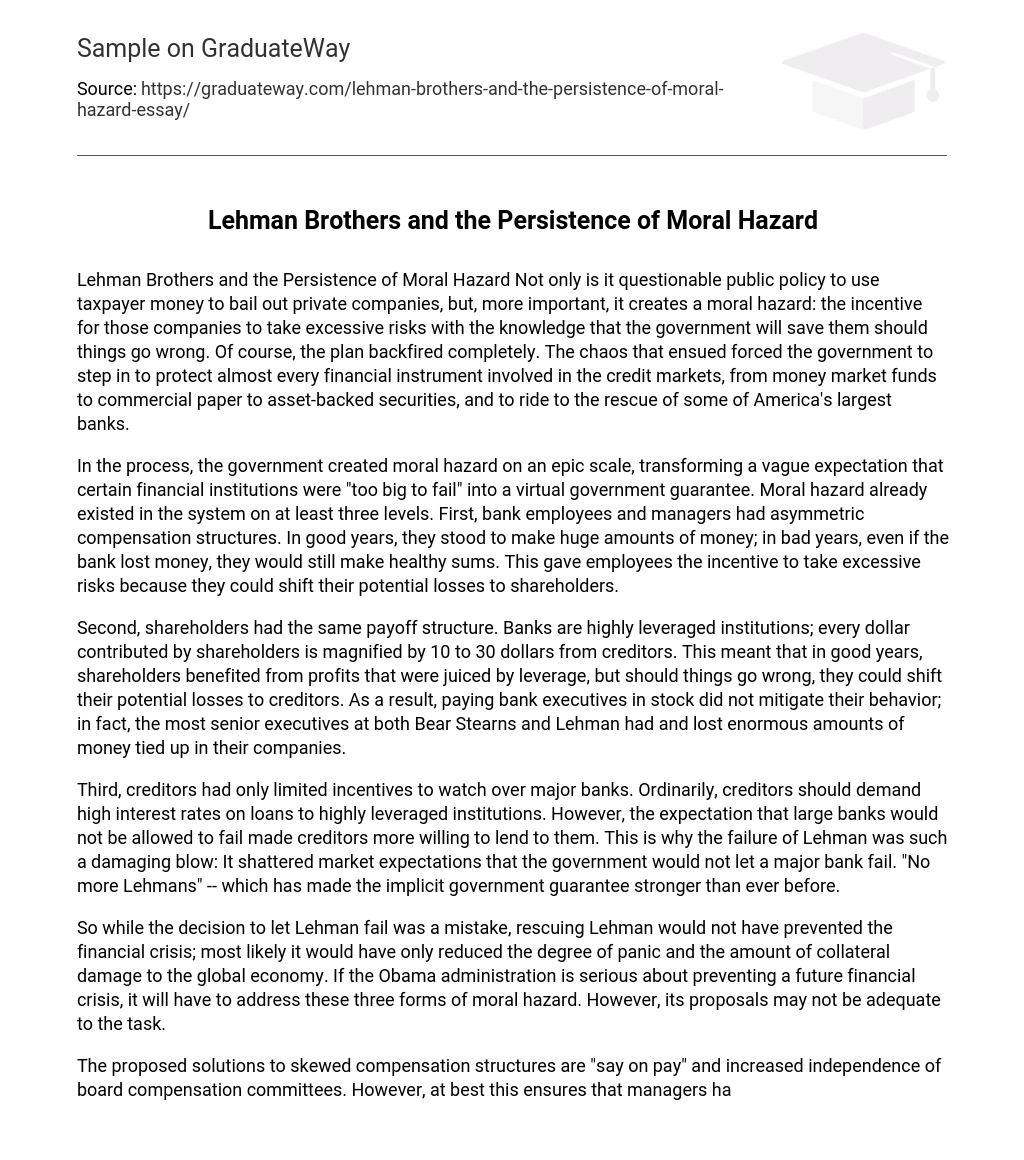Utilizing taxpayer funds to save private enterprises poses public policy challenges and generates a moral dilemma. This predicament incentivizes companies to engage in undue risk-taking, as they anticipate government intervention in the event of unfavorable outcomes. Regrettably, this methodology proved futile and led to extensive turmoil. Consequently, the government had to step in and safeguard various credit market instruments such as money market funds, commercial paper, and asset-backed securities. Additionally, numerous prominent banks in the United States necessitated governmental aid.
The government’s actions resulted in a notable moral hazard, essentially transforming the notion that specific financial institutions were “too big to fail” into an indirect government assurance. Moral hazard already existed at various levels within the system prior to this occurrence. At first, bank employees and managers had uneven compensation structures. During prosperous periods, they could earn substantial sums of money. Nonetheless, even during difficult years when the bank experienced losses, they would still receive significant amounts. This incentive prompted employees to take extreme risks since any potential losses could be shifted onto shareholders.
Secondly, shareholders possessed identical payoff structure. Banks are significantly leveraged establishments; each dollar invested by shareholders is amplified by 10 to 30 dollars from creditors. Consequently, in prosperous times, shareholders reaped the rewards of profits augmented by leverage. However, in case of any mishaps, they had the ability to transfer their potential losses onto creditors. As a consequence, compensating bank executives in stock did not diminish their actions; in reality, the topmost executives at both Bear Stearns and Lehman materialized to have and eventually lost vast sums of money linked with their respective organizations.
In addition, there were few incentives for creditors to oversee significant banks. Normally, when lending to highly leveraged institutions, creditors would demand high interest rates. Nonetheless, the assurance that large banks would not be allowed to fail boosted creditors’ readiness to lend to them. This is why the downfall of Lehman had such a negative impact: it undermined the market’s trust in the government’s dedication to preventing major bank failures. Consequently, the implicit guarantee from the government has become even more robust, as evidenced by the phrase “No more Lehmans.”
Although allowing Lehman to fail was a mistake, it would not have been enough to stop the financial crisis. Rescuing Lehman would have likely lessened the panic and damage to the global economy. To prevent future financial crises, the Obama administration needs to tackle these three types of moral hazard. However, its proposed solutions may not be sufficient.
The suggested remedies for imbalanced compensation structures include implementing “say on pay” and enhancing the autonomy of board compensation committees. Nevertheless, these measures merely guarantee that managers align their interests with shareholders, a phenomenon that is mostly present already. These reforms fail to tackle the issue that shareholders appreciate the high leverage nature of banks. To curb moral hazard, an alternative approach is to grant the government the authority to resolve large financial institutions, akin to the FDIC’s ability to close commercial banks.
The government would have the power to wind down a bank in an organized manner by imposing “haircuts” on creditors. This would motivate creditors to monitor their borrowers more closely. The effectiveness of resolution authority lies in the belief that the government would actually utilize it to harm shareholders and creditors, despite the government’s recent insistence that causing harm to either is not advisable.
The Treasury Department is suggesting more stringent capital requirements to increase difficulty for large banks in borrowing funds, but this action alone would only partly address the issue of reducing damage caused by a failing bank. Unless we can effectively diminish moral hazard, stricter regulation remains the sole alternative. Through these regulations, the government would possess authority to ensure ethical behavior. It might require extensive time and experimentation to proficiently handle moral hazard.





